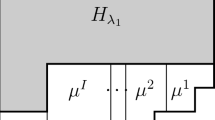Abstract
The Abelian/non-Abelian correspondence for cohomology (Martin in Symplectic quotients by a nonabelian group and by its maximal torus. arXiv:math/0001002 [math.SG], 2000; Ellingsrud–Strømme in On the chow ring of a geometric quotient, 1989) gives a novel description of the cohomology ring of the Grassmannian. We show that the natural generalization of this result to small quantum cohomology applies to Fano quiver flag varieties. Quiver flag varieties are generalisations of type A flag varieties. As a corollary, we see that the Gu–Sharpe mirror to a Fano quiver flag variety computes its quantum cohomology. The second focus of the paper is on applying this description to computations inside the classical and quantum cohomology rings. The rim-hook rule for quantum cohomology of the Grassmannian allows one to reduce quantum calculations to classical calculations in the cohomology of the Grassmannian. We use the Abelian/non-Abelian correspondence to prove a rim-hook removal rule for the cohomology and quantum cohomology (in the Fano case) of quiver flag varieties. This result is new even in the flag case. This gives an effective way of computing products in the (quantum) cohomology ring, reducing computations to that in the cohomology ring of the Grassmannian.
Similar content being viewed by others
Notes
As we consider the Grassmannian of quotients, our conventions are transpose to some of the literature.
There are slightly more general rim-hooks, but these are the only ones we will need.
References
Audin, M.: An introduction to Frobenius manifolds, moduli spaces of stable maps, and quantum cohomology (1997)
Batyrev, V.V.: Quantum cohomology rings of toric manifolds. Journées de géométrie algébrique d’Orsay - Juillet 1992, Astérisque, no. 218, Société mathématique de France pp. 9–34 (1993)
Behrend, K., Fantechi, B.: The intrinsic normal cone. Invent. Math. 128(1), 45–88 (1997)
Bertram, A., Ciocan-Fontanine, I., Fulton, W.: Quantum multiplication of Schur polynomials. J. Algebra 219(2), 728–746 (1999)
Ciocan-Fontanine, I., Kim, B., Sabbah, C.: The abelian/nonabelian correspondence and Frobenius manifolds. Invent. Math. 171(2), 301–343 (2008)
Ciocan-Fontanine, I., Kim, B.: Wall-crossing in genus zero quasimap theory and mirror maps. Algebraic Geom. 1 (2013)
Coates, T., Iritani, H., Jiang, Y.: The crepant transformation conjecture for toric complete intersections. Adv. Math 329 (2014)
Cox, D.A., Katz, S.: Mirror symmetry and algebraic geometry, Mathematical Surveys and Monographs, American Mathematical Society, United States (1999) (English (US))
Craw, A.: Quiver flag varieties and multigraded linear series. Duke Math. J. 156(3), 469–500 (2011)
Ellingsrud, G., Stromme, S.A.: On the Chow ring of a geometric quotient. Ann. Math. 130(1) 159–187 (1989)
Givental, A.: A mirror theorem for toric complete intersections. Topological field theory, primitive forms and related topics (Kyoto, 1996), Progr. Math., vol. 160, pp. 141–175. Birkhäuser Boston, Boston, MA (1998)
Gu, W., Sharpe, E.: A proposal for nonabelian mirrors (2018). arXiv:1806.04678 [hep-th]
Kalashnikov, E.: Four dimensional Fano quiver flag zero loci (with an appendix by T. Coates, E. Kalashnikov, and A. Kasprzyk). Proc. R. Soc. A 475 (2019)
Kalashnikov, E.: Quiver flag varieties and mirror symmetry, Ph.D. thesis, Imperial College London (2019)
King, A.D.: Moduli of representations of finite-dimensional algebras. Quart. J. Math. Oxford Ser. (2) 45(180), 515–530 (1994)
Kontsevich, M.: Enumeration of rational curves via torus actions, The moduli space of curves (Texel Island, 1994), Progr. Math., vol. 129, pp. 335–368. Birkhäuser Boston, Boston, MA (1995)
Li, J., Tian, G.: Virtual moduli cycles and Gromov-Witten invariants of algebraic varieties. J. Am. Math. Soc. 11(1), 119–174 (1998)
Lian, B., Liu, K., Yau, S.T.: Mirror principle I, The Asian. J. Math. 1(4), 729–763 (1997)
Martin, S.: Symplectic quotients by a nonabelian group and by its maximal torus (2000). arXiv:math/0001002 [math.SG]
Webb, R.: The Abelian-Nonabelian Correspondence for I-Functions. Int. Math. Res. Not. 2023(3), 2592–2648 (2021)
Acknowledgements
The second author is very grateful for helpful conversations with Anders Buch, Tom Coates, Alastair Craw, Allen Knutson, and Lauren Williams.
Author information
Authors and Affiliations
Corresponding author
Additional information
Publisher's Note
Springer Nature remains neutral with regard to jurisdictional claims in published maps and institutional affiliations.
Rights and permissions
Springer Nature or its licensor (e.g. a society or other partner) holds exclusive rights to this article under a publishing agreement with the author(s) or other rightsholder(s); author self-archiving of the accepted manuscript version of this article is solely governed by the terms of such publishing agreement and applicable law.



